Are your chickens scratching relentlessly, losing feathers, and generally in a miserable mood? If so, they probably have mites – or poultry lice. These nasty little infestations happen frequently, especially when birds are living in close quarters.
Chicken mites will not kill your birds unless untreated for an extended period of time. Thankfully, mites and poultry lice are fairly easy to both get rid of and prevent without being reduced to using potentially harmful chemical products on the flock.
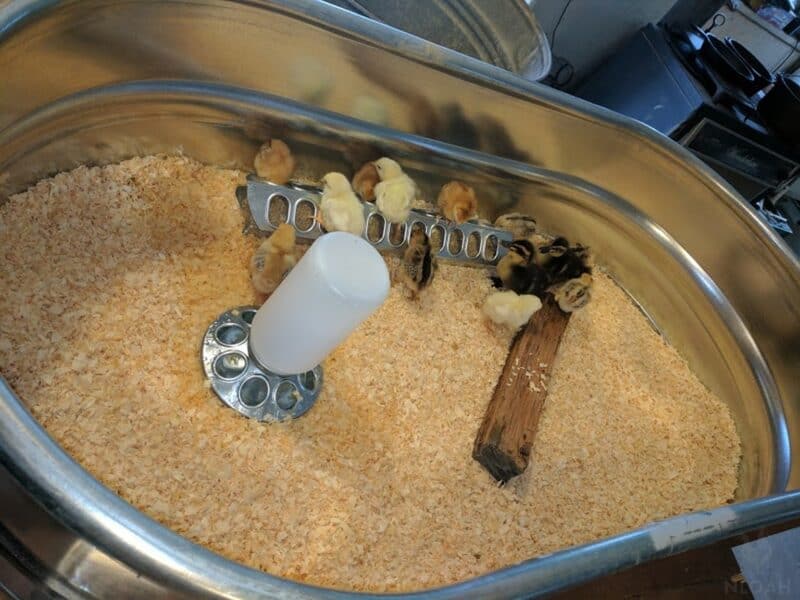
What Are Chicken Mites, Anyway?
Mites are external parasites living on chickens and other fowl and feeding on their blood.
Chicken mites can become deadly if left untreated, especially in chicks.
When the bird scratches at the mites and creates open wounds, the other chicks are prone to attacking the bird after being drawn to the sight and smell of blood – this happens even more frequently when raising turkeys.
How Can You Tell If The Flock Is Infested?
The mites and lice travel from host to host in search of a home, much like human lice. They can be transmitted from bird to bird or often times, from rodents and other animals who live near the chicken coop and run area.
Mites tend to look like little brown spots on the flesh of a chicken. An infestation almost looks like someone splattered mud onto the bird – until the “mud” starts to move about slowly on the chicken’s body.
Chicken mites can also appear as little gray specks or reddish specks on a bird’s body. The miniscule parasites have eight legs that are far too tiny for the eye to see.
There are three most common types of chicken mites:
- the northern fowl mites,
- red mites,
- and scaly leg mites.
Red Mites
Red mites, also known as red roost mites, prefer to inhabit the coop roosts, nesting boxes, and cracks in the wood frame of the coop and run, when not making their home on a bird. The mite colonies are fairly nocturnal, they often wait until it is dark to leave their colony to leech blood from your flock.
These mites are some of the most common types to affect chickens, and also one of the most annoying to treat. These creatures cause small black and red spots to appear, and left untreated, can cause your chickens to become anemic. Red mites are almost always introduced to your coop by the passage of wild birds.
It should also be noted that red mites can spread a variety of diseases as well. These pests can spread equine encephalitis viruses, Salmonella, Coxiella burnetii, and fowl poxvirus, among other pathogens. Therefore, getting rid of them should be a top priority.
Northern Fowl Mites
These mites are similar to red mites in that they also feed on your chickens’ blood. However, red mites will not spend their entire lives on your chickens, while Northern Fowl mites will.
This means that your chickens will begin to suffer from the negative impacts of a mite infestation much more quickly if they are exposed to Northern Fowl mites versus red mites. Anemia can set in very quickly.
As with red mites, Northern Fowl mites are spread by wild birds but also by rodents.
Scaly Leg Mites
You won’t be able to see Scaly Leg Mites on your chicken with the naked eye – however, you will be able to see the impact they produce on your chickens without any kind of ocular assistance.
These pests feed on the scales of your chicken’s feet and legs. They will also leave droppings there. As a result, the legs of your birds will look crusty, scabby, and sore. These mites can spread very quickly and if left untreated, can cause death of your chickens as they invite further infection.
In some cases, Scaly Leg mites can cause the feet and leg scales of your birds to become heavily raised, causing permanent lameness, a loss of appetite, and more.
Scaly leg mites are spread by new birds, and keeping your coop especially clean can help get rid of these pests. Often, you can treat Scaly Leg mites in your chickens by giving them a gentle soak in a tub of lukewarm water.
Other Types of Chicken Mites
While the Red Mite, the Northern Fowl Mite, and the Scaly Leg Mite are the most common types of mites to infest chickens, there are more that you should be aware of.
For example, the Tropical Fowl Mite (common in southern states like Texas and Florida) lays more eggs than Northern Fowl Mites and infests a wide variety of hosts, including turkeys and chickens. You also might find cyst mites, feather mites, depluming mites, or common chiggers on your chickens, but these are much less common.
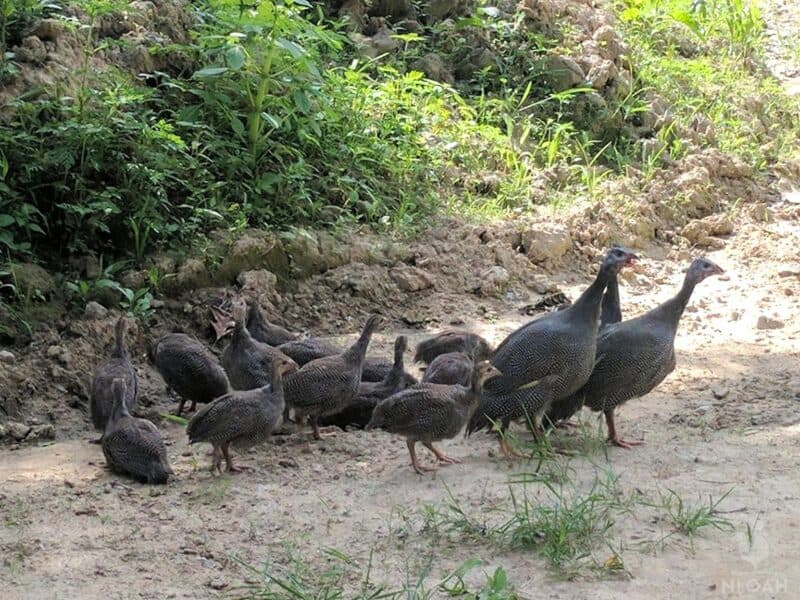
Chicken mites of all kinds can afflict guinea flocks as well. The more all of your flocks are exposed to natural dirt for “bathing” or dirt “baths” created inside their run, the less likely it is that a chicken mite infestation will take hold. You can keep your chicken coop impeccably clean, and still experience a chicken mites infestation.
Chicken mites can live for as long as 34 weeks between feedings. Therefore, it’s important that you make sure you are diligent about cleaning and that you never reuse any materials that were exposed to a chicken mite infestation.
Are Chicken Lice and Mites the Same Thing?
It would be nice to assume that all itch-inducing problems in your flock are caused by the same creature. Unfortunately, this is not the case. While both are small, annoying, and capable of causing a lot of heartache among your flock, they are different.
The difference between lice and mites is that lice typically feed on the skin scales and debris in your birds’ feathers, while mites feed on blood. Lice can live their entire lives on your chickens, and like mites, can also be detrimental.
They are transmitted in similar fashions, but the treatments are somewhat different. Therefore, if you suspect that your chicken might have lice instead of mites (lice usually are found on the underside of your chickens’ feathers, near the shaft of the feather), you will need to take different steps to remove them.
How To Inspect Chickens For Mites
A magnifying glass and a chicken that holds very still while it is examined would be required to visually identify which type of infestation you are battling.
There is really no need to inspect a bird so closely to discover if chicken mites have set up housekeeping.
You merely need to learn how to identify the symptoms and signs that an infestation has occurred so you can take the necessary steps to thwart it. Only in severe and long-term cases could a chicken mite infestation cause the death or humane slaughter of a poultry bird.
Inspecting each individual chicken twice each month for signs of an infestation should serve as an early mites or lice presence warning system.
When allowed to remain together, a mother hen will instinctively check her chicks for mites and attempt to remove them.
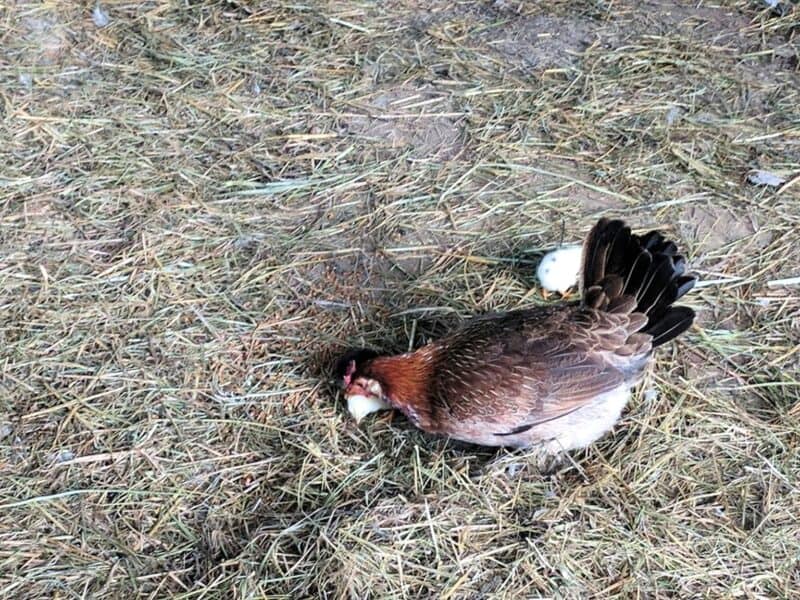
How To Inspect Chickens For Signs Of Mites
- Look at their vent feathers closely. If the feathers around the vent area particularly dirty, carefully look the bird’s flesh over more carefully so as to crawl tiny mites or lice.
- Pay attention to the daily or weekly behavior of each chicken. If a bird suddenly moves about a lot less frequently or shows signs of general fatigue, look it over more thoroughly for signs of mites.
- If the chicken’s comb begins to boast a more pale hue, a mites infestation could be occurring on the bird.
- Should egg production decrease suddenly, check the hen over immediately for signs or mites, lice, or other common poultry ailments. Egg production frequently drops off in chickens affected by both mites and lice.
- Weight loss is another potential indication of a mites infestation. Weighing the birds twice each month, or even once per month, will help you better gauge their overall health.
- Scabs near the vent of the chicken are another indicator of a mites infestation in the present, and likely has been for at least a little while.
- If your chickens have white or light colored feathers, they may become darkened or discolored due to the feces dropped by the mites.
- Feathers on poultry often become disheveled or ragged in appearance when they are combating mites.
- Both chicken mites and lice tend to lay their eggs on the feathers of birds, checking that area closely both during and after an infestation treatment to ensure their parasites are all gone.
- Observe the behavior of your chickens. Are they hesitant to go into the coop at night? If so, it could be because they are being chewed on at all hours int here.
- You might notice smears of blood on the eggs. This can be caused by straining or other natural causes during egg production, too, but combined with any of these other symptoms can be indicative of a chicken mite infestation.
It is always a good idea to inspect birds weekly, if possible, and keep a health journal on each bird. Following this practice will help you determine not only if mites and lice are about, but also if other common poultry ailments are emerging and to keep track of egg production.
When inspecting each chicken, pay special attention to your brooding hens. The hens are too focused on laying or sitting their eggs to take regular dust baths – which help ward of mice and lice.
Furthermore, because broody hens have a tendency to pull their own feathers out to cushion and warm their eggs, it may appear that your hen is simply broody when she also has a mite infestation.
If you have ever left the coop with irritated and slightly burning skin, it is likely the mites that are infecting your birds, decided to take a bite out of you, as well.
Although mites don’t cause such dramatic symptoms in us (like drooping wings, a pale comb, and sickly-looking wattles), they can still cause significant skin irritation.
Still not totally sure that you have a mite problem? Walk into your coop when it’s dark outside and carry a torch and a piece of white paper with you.
Shine your light on the roost bars – if you have a lot of mites, you might be able to see them. You can also rub your paper along the base of the bars. If it comes back with red smears on it, you probably have a mite infestation.
How To Prevent Chicken Mites
Before we delve into how to deal with chickens with mites, let’s take a few moments to better understand the prevention of chicken mites (as much as humanly possible) in the first place – and make sure your coop is rid of them after an infestation has been detected.
Birds and other wildlife are generally considered the biggest carriers of chicken mites and lice. If you live in an urban area and the flock is confined to a coop and run, common sense would tell you that the birds are better protected from mites than, say, free range flocks. But, that does not seem to be the case.
Because free range birds have more access to dust bath opportunities mites are less likely to choose them for a host. Also, because free range birds are not living in confined quarters for the bulk of their lives, bird to bird transfer of mites is also decreased.
I tell you this not because I am die-hard free ranger who is blessed with the space to do so, but because all poultry keepers need to know no matter how the chickens are housed, and there are pros and cons to all methods, EVERY flock is susceptible to some degree, of contracting mites.
How you choose to raise your birds matters, but opting for one type of housing over another because it will keep the flock protected from mites and thinking your job is done, will ultimately leave the chickens more vulnerable to the parasites.
Quarantine New Birds
Quarantine new additions to the flock for at least two weeks before moving them into general living quarters. Inspect the new birds daily for signs of mites, lice, and other illnesses.
Put Up Physical Barriers
If you have wild birds nearby that have a tendency to roost or sit atop your coop or anywhere near your chicken yard, you need to erect some sort of structure to stop them from doing that.
Wild birds are the most common carriers of red mites, and so putting up a guard atop your coop or a similar measure can help prevent new mite infestations from being introduced.
Keep Feed Stashed Away
Store feed in an airtight container to prevent mites or other unwanted pests from getting inside. I always toss 2 cups of diatomaceous earth in with every 50-pound bag of feed to ward off pests.
The diatomaceous earth can also serve as a natural dewormer for your chickens and as a detoxifying agent. The DE cuts into the hide of insects to deter their entry and also absorbs into their skin to dehydrate them, smothering the pest from the inside out.
Remove Infected Material
Remove potentially contaminated feathers found in the coop and run on a regular basis.
Limit Moisture
Do your best to eliminate excess moisture in the coop. Chicken mite infestations are more common after prolonged periods of wet weather, so if you can provide good ventilation and continuously supply your coop with fresh, dry bedding, your odds of preventing a chicken mite infestation are higher.
Get the Birds Out of the Coop
If you have chickens that are infested with chicken mites – but it doesn’t appear that all of your birds are infested – move them out of the coop. Do not try to treat an infestation until you have isolated the infected birds.
All of your chickens should be removed from the coop regardless. This will allow you to thoroughly sanitize the coop and to treat your chickens without worrying about re-infestation or further spread of the pests.
Keep Your Coop Clean
The old adage used to be that if you had a chicken mite infestation, that meant you had to burn the coop down. Luckily, that’s not the case! However, the advice still holds that you need to conduct an extremely thorough cleaning of the coop.
Make sure you pay special attention to the nesting boxes. Dispose of any bedding and do not put it in the compost. Spray it with a high-pressure hose, getting water into every nook and cranny.
Let it dry out for a few hours, then spray it again. You can use chicken-friendly detergent soaps or a mixture of vinegar and baking soda to get it extra sparkling clean.
Moving forward, proper maintenance will be key to keep an infection from coming back. Put fresh straw in the coop and run weekly or bi-weekly, as your budget allows.
Clean out nesting boxes and hose down the inside of the coop, including the roosts, at least one per month. I use a mixture of 2 tablespoons of Blue Dawn, 1 cup of cooking or carrier oil per every 2 cups of water when cleaning my coop and run.
This spray should help get rid of the mites by suffocation, but make sure you shake the mixture well before applying it because it will separate. For best results, use it once a month – once or twice a week is even better, particularly if you suspect a mite infestation.
The deep litter method of bedding is an effective way to prevent mites from infesting your chickens, too, but be advised that it may not be as successful in the hot summer months, when your chickens will likely spend less time in the coop.
Maintain a Good Dust Bath Area
Keep a dust bath filled with dirt, sand, and diatomaceous earth, large enough to accommodate all of your hens. Dump and refresh the dirt every three months.
Dust the Birds With Pestene
This isn’t a treatment that all chicken owners would want to use, as is a combination of Sulphur and rotenone.
Rotenone is widely viewed as a toxic chemical, but many industrial chicken farmers use Pestene on the farm to get rid of chicken mites. It is one of the most effective measures of getting rid of chicken mites – but not necessarily organic. It should be viewed as a last resort.
Use Diatomaceous Earth
Sprinkle FOOD GRADE diatomaceous earth every 2-3 months in your nesting boxes to deter mites and other parasites from making it their home. Commercial grade DE can be extremely harmful for humans and livestock to inhale.
Dust will always consume the air for a few moments when pouring any type of DE. Sprinkle the DE slowly and carefully to decrease the amount of dust, pour while wearing a mask, and/or in a well ventilated area.
Keep an Eye on the Little Ones
Chicken mite infestations can spread rapidly in brooder chicks and ducklings because of both the extreme close quarters and their apparent attraction to heat during cold seasons.
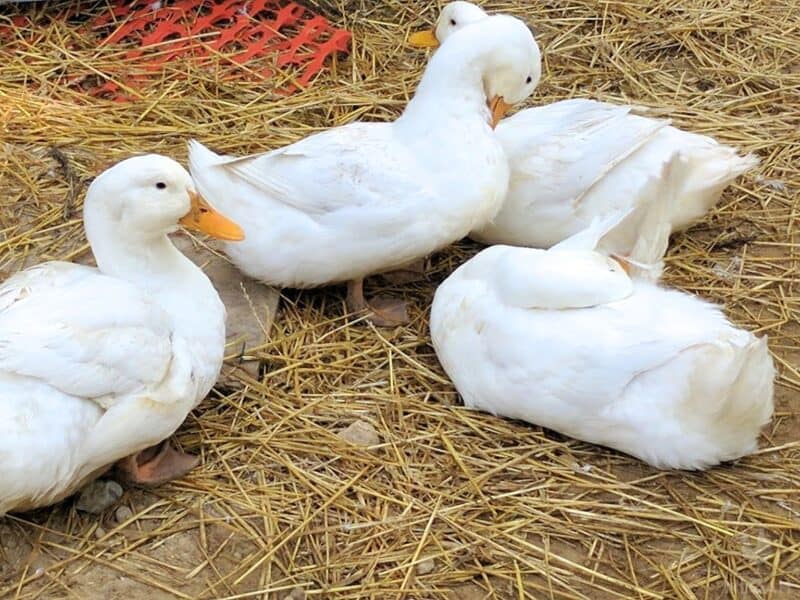
Natural Treatments For Chicken Mites
Sprinkling specific spices in coop feeders and waterers, as well as in a small tub to munch on free choice, should help the flock heal from the bites and sores caused by the parasites.
I routinely use the following herbs and dried flowers with my flock to treat parasite infestations and other common poultry ailments:
Garlic
1. Garlic – The multi-purpose natural healing food/spice has been known to work superbly at repelling multiple types of parasites in livestock both small and large. In addition, a diet that is rich in garlic can help prevent chicken mites from becoming a bigger problem in your flock, as it will boost your birds’ immune systems.
Wormwood
Wormwood, also known as artemisia, can repel mites easily. All you need to do is tie a delicate bouquet of wormwood on the roosts and it should keep mites away.
Cayenne Pepper
This spice is routinely regarded as a strong natural parasite killer.
Calendula
Dried petals from this flower have been known to help ward off and treat parasite infections. Calendula may also reduce blood clots and help reduce soft eggshell laying by hens.
Cinnamon
It boasts natural immune system compounds and is known to help reduce inflammation while also working as a natural antifungal agent.
Turmeric
This spice is often regarded as a strong natural antibiotic and also possesses anti-inflammatory compounds. It can also help treat the swelling associated with bumblefoot and enhance the immune system of brooding hens in particular.
Ginger
I use ginger regularly with my flock because of its natural healing properties and the belief that the spice can help harden egg shells and perhaps increase egg production.
Lavender
Lavender has been proven to be a powerful insecticide, repelling and controlling nearly every type of pest, including lice and chicken mites.
To use lavender essential oil to repel chicken mites, simply mix a few drops in some water and spray the mixture on chickens and their housing areas. Reapply every two days until the chicken mites are gone.
Lavender essential oil is also useful for other pest control around the home, like ticks and fleas – just make sure to use it sparingly as this essential oil can be quite potent!
Thyme
Thyme works by both killing the adult mites and inhibiting the eggs from hatching, resulting in long-term protection for your chickens. This essential oil can be added to water for spraying on and around your chickens, or even put directly on their feathers, depending on the situation.
Bay Leaves
To use this remedy, simply line the chicken coop with bay leaves, either crushed or whole. As the mites crawl around and come into contact with the bay leaves, they irritate and eventually die off.
Some farmers and home-growers report that using an increased amount of bay leaves to line the floor of the chicken coop over a period of time can be more effective.
You can also use an herbal spray containing bay leaf extract that has been known to work quite effectively for larger infestations of chicken mites.
Oregano
The spice is another great immune system booster with healing properties. It may also help fend off the deadly coccidiosis, avian flu, and poultry respiratory illnesses.
Peppermint
Peppermint is great at repelling a number of pests. Whether it’s flies or mites that are bugging your chickens, you might want to consider sprinkling some of this herb in your chicken coop to keep the pests away.
Black Pepper
This spice has antibacterial and antioxidant properties that can help chickens (other livestock and humans as well) heal both naturally and more quickly from various injuries and illnesses.
Predator Mites
Some chicken farmers have used predator mites on their farm with some success. This isn’t necessarily recommended for all flocks, and should only be done with great caution.
These mites could introduce secondary infections or problems, but there are several types of mites that supposedly do a great job of eating up all of the chicken mites – without creating any other problems.
Wood Ash
Wood ash is believed to be an effective treatment to get rid of and prevent chicken mites. You should only use ash from untreated wood, as you don’t want to expose your chickens to any chemicals or pesticides.
To use wood ash on your chickens, dust them thoroughly when they are infested. You can dump it into a bucket and just swish it around in your chickens’ feathers. Make sure it is completely dry, however, because if it is wet, it could burn your hens’ skin.
Iron
Iron won’t necessarily do anything to combat a mite infestation, but it’s a good idea for you to increase the iron content of your birds if they have been exposed to a mite infestation.
Because anemia is the most common side effect of a bad mite problem, adding iron to the diet can help prevent any losses or health problems in your flock. Some good iron-rich foods include:
| Meat | Fish |
| Spinach | Dandelion Greens |
| Broccoli | Kale |
| Watermelon | Wheat |
| Cornmeal | Oatmeal |
| Molasses | Raisins |
| Strawberries | Collards |
| Sweet potatoes | Beets and beet greens |
| Scrambled eggs | Shellfish |
Suffocate the Mites
You can also rub the birds down with apple cider vinegar, cooking oil, mineral oil, or your favorite carrier oil, to smother the chicken mites.
Use Neem Oil
To begin, mix 1 teaspoon of pure neem seed oil with 8 tablespoons of mild liquid soap into a cup of warm water. Add 1 tablespoon of this mixture per gallon of water in an atomizer or spray bottle and apply it directly to the bird and its coop or coop area.
Be sure to thoroughly cover all areas, paying special attention to cracks, nooks and air vents where mites might hide.
Try Dish Soap
Start by spraying down all coop walls and surfaces with a mixture of 2 cups water and 2 tablespoons of mild liquid dish soap, taking care to get into any crevices or cracks.
Coat their nesting boxes as well, making sure you are using pure soap without any added scents or fragrances that could be harmful to your birds. After 15 minutes of contact time, spray the mixture off with plain water. You can repeat this process every 1-2 weeks if necessary.
Natural Chicken Mites Spray
Ingredients
- 2 ounces garlic juice
- 16 ounces water
- 1 teaspoon any of the two following spices: cinnamon, lavender, coriander, thyme, basil, bay leaves, spearmint, or cloves
Instructions
- Mix all ingredients together and pour into a squirt bottle.
- Spray the flock once each week as a preventative or twice each week once an infestation has been detected.
- Store the mixture for up to 1 month in a cool, dry place.
No matter how hard you try to avoid it, mites will almost certainly infest at least a few members of your flock. The tips above will help you both decrease such occurrences, help you detect infestations early, and aid in the removal of the parasites.
Once chicken mites have been found on a single bird, treat the entire flock, even if the other hens and roosters show no visible signs of the parasites. Once the birds have been treated, remove them from the coop and run temporarily and thoroughly clean and disinfect the entire area before allowing the flock to return.
Having trouble getting rid of chicken mites in your flock? Share details about your problem in the comments section below and we will try to help you figure out a way to help your chickens get rid of the vile parasites.
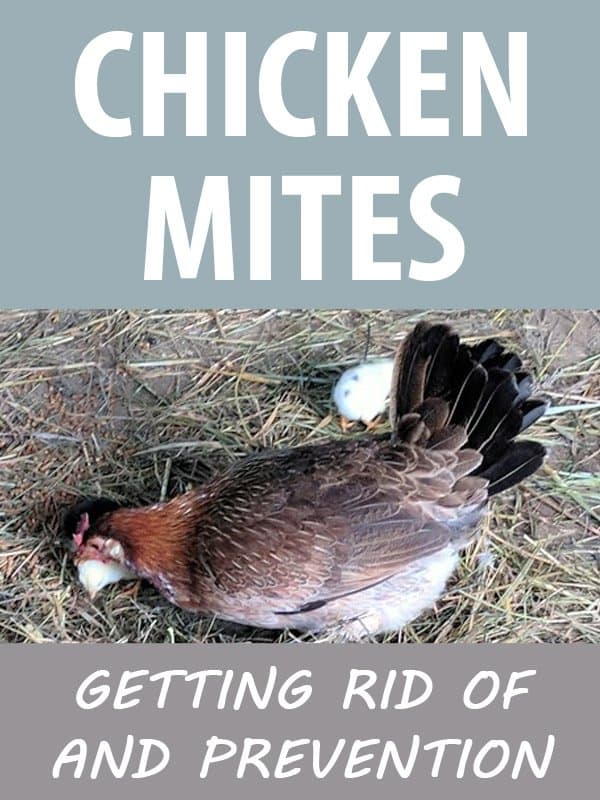

Tara lives on a 56 acres farm in the Appalachian Mountains, where she faces homesteading and farming challenges every single day, raising chickens, goats, horses, and tons of vegetables. She’s an expert in all sorts of homesteading skills such as hide tanning, doll making, tree tapping, and many more.
